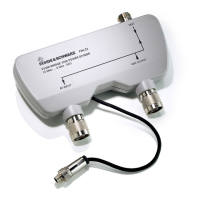R&S
®
CMW 500 Remote Control
Status Reporting System
Operating Manual 1202.3986.32 – 03 110
Parallel poll procedure
In addition to the SRE register, which determines the conditions under which an SRQ
is generated, there is a Parallel Poll Enable register (PPE) which is ANDed with the
STB bit by bit, considering bit 6 – AND as well. This register is ANDed with the STB bit
by bit, considering bit 6 as well. The results are ORed, the result is possibly inverted
and then sent as a response to the parallel poll of the controller. The result can also be
queried without parallel poll by means of the command "*IST?".
The instrument first has to be set for the parallel poll using the Visual BASIC command
"IBPPC()". This command allocates a data line to the instrument and determines
whether the response is to be inverted. The parallel poll itself is executed using
"IBRPP()".
The parallel poll method is mainly used to find out quickly which one of the instruments
connected to the controller has sent a service request. To this effect, SRE and PPE
must be set to the same value.
5.6.4.4 Query of an Instrument Status
Each part of any status register can be read by means of queries. There are two types
of commands:
The common commands *ESR?, *IDN?, *IST?, *STB? query the higher-
level registers.
The commands of the STATus system query the SCPI registers
(STATus:QUEStionable...)
All queries return a decimal number which represents the bit pattern of the status
register. This number is evaluated by the controller program.
Decimal representation of a bit pattern
The STB and ESR registers contain 8 bits, the SCPI registers 16 bits. The contents of
a status register is keyed and transferred as a single decimal number. To make this
possible, each bit is assigned a weighted value. The decimal number is calculated as
the sum of the weighted values of all bits in the register that are set to 1.
Bits 0 1 2 3 4 5 6 7 ...
Weight 1 2 4 8 16 32 64 128 ...
Example: The decimal value 40 = 32 + 8 indicates that bits no. 3 and 5 in the status
register (e.g. the QUEStionable status summary bit and the ESB bit in the STatus
Byte) are set.
Queries are usually used after an SRQ in order to obtain more detailed information on
the cause of the SRQ.

